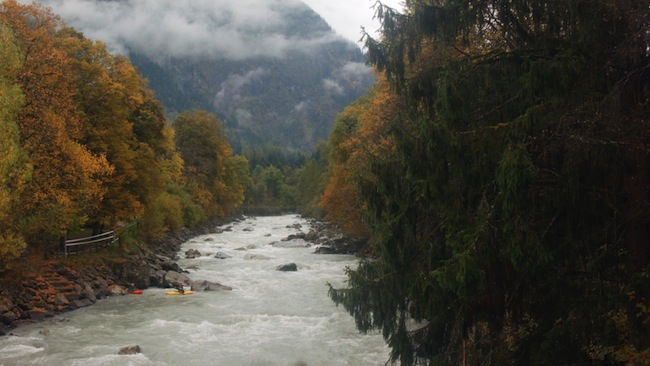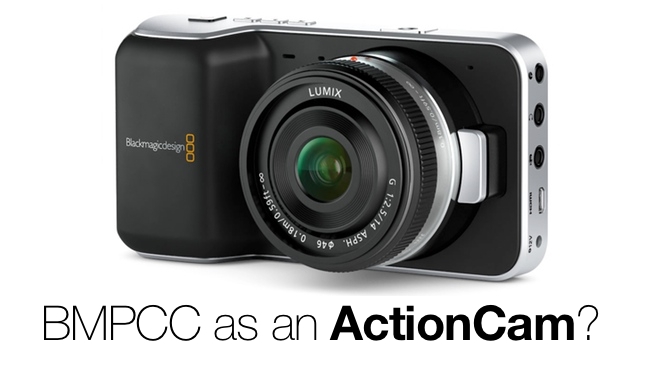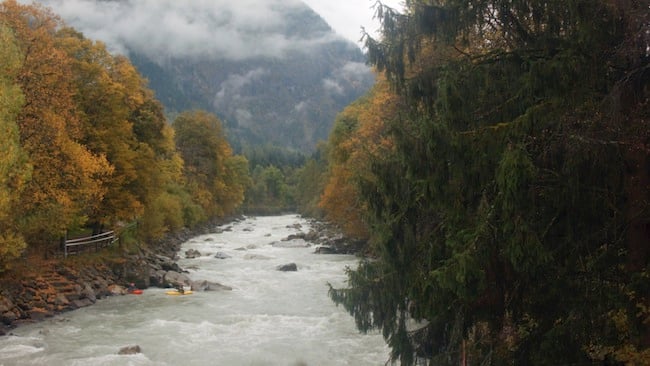
 Rapid shot
Rapid shot
A little over a year ago Blackmagic Design released the Pocket Cinema Camera, a device that promised 13 stops of range while recording to either Prores or Cinema DNG raw in a tiny package small enough to fit in your pocket. Can it be used for extreme sports? Clearly you can't hammer it like a GoPro but Red Shark’s Simon Wyndham recently got the chance to try one of them out during a whitewater shoot in Austria.
The shoot followed whitewater kayaker Eddy Mead as he entered the world renowned Adidas Sick Line Extreme Kayak championship. Taking place on the Wellebrucke rapids on the river Oetz in the Austrian alps I knew that this would be a great test for the camera. In the late morning the Wellebrucke canyon is often half in extreme backlit sunlight, and half in shadow. The terrain is also difficult to access, so a light camera is extremely beneficial to have.
I did not take a cage rig with me as I wanted to travel light. The Pocket Cinema Camera is designed as a small compact device and I wanted to try it out as such. I took with me an Olympus Zuiko 14-42mm lens, which is not the fastest around with a maximum aperture of f/3.5 going down to f/5.6 at the long end. However it made for a versatile combination with just enough on the wide for most purposes, and a good telephoto range.
Sensor specs and lens choice
The BMPCC utilises a roughly S16mm sized sensor (12.48mm x 7.02mm), which gives it a crop factor of around 3.02 compared to a full frame camera base level. This makes good wide angle lenses difficult to find, however companies such as Samyang now make some nice manual 10mm cine primes at very reasonable prices. Such a lens would give you a similar angle of view to a 30mm lens on a full frame camera.
There is also now the option of purchasing the new Metabones Speed Booster, which has been specifically designed for the BMPCC. Such an adaptor will enable you to keep your current EF lens investments, as well as the ability to use great new EF cine primes such as the Tokina Cinema ATX 11-16mm T3.0, while keeping their APS-C designed angle of view.
Why get excited about 1080p?
You are probably thinking by now that this is all very well, but why would I be so excited about a small camera that cannot do 4K in the current market situation? The BMPCC is also just over a year old already. Surely it is yesterday’s news?
I have good reason. 4K is coming whether we like it or not, but at the present time most of us simply do not need it for the majority of output. In fact many of my current clients complain about their computers stuttering when it comes to playing 1080p HD, let alone 4K! There is plenty of life left in good old HD for the time being.
What excites me about the BMPCC is that good quality 10-bit log Prores and 12-bit lossless compressed DNG raw recording is available on such a small and portable device.
It means that footage that I take while in more remote and harder to access places will now look great rather than the mush that many DSLRs output. Certainly I could hack a DSLR, but that is not ideal for reliable professional recording. I could also purchase a Panasonic GH4, which looks like it will soon have a Log gamma recording mode of its own. However that is still a more bulky camera at twice the price of the BMPCC.
Build quality and general features

When you first take the BMPCC out of the box you find that, much like its larger cousins, it is very nicely built and feels great in the hand. The body is made from metal with a rubbery type coating on the front making it easy to grip. It also looks very discrete and a bit retro. Most people will think that it is a compact stills camera, which makes it great for blending into the background.
The rear screen is nicely defined in normal indoor light. However in strong outdoor sunlight it is next to impossible to view. Some sort of loupe would be very useful, if not essential. For production where discreteness is not the prime requirement I will be using the camera with an add-on EVF.
The BMPCC originally shipped with basic firmware features. With the latest software the camera now sports a responsive realtime histogram to help with exposure, as well as realtime audio metering with DBFS markings. Very handy. These can be removed from the display with a quick tap of the down arrow button.
In general the camera is a breeze to use. It is simple, yet all the important functions are very easy to access. With auto lenses the Iris button makes exposure easy before fine adjustments can be made with the left and right arrow buttons. The Focus button also makes focussing easy. I wouldn’t normally use such auto functions, but in this case they make life easy.
Double tapping the Focus button turns on the focus peaking, while double tapping the OK button digitally zooms in on the picture to allow for absolute confirmation of focus. A single press of the OK button allows shot metadata to be input. This is a bit fiddly with the lack of a keyboard, but still a useful function nonetheless.
The BMPCC comes equipped with a 3.5mm headphone socket, a 3.5mm audio input jack, an industry standard LANC socket, and a micro HDMI output. There is also a 12 volt in socket for external powering. Like many I do wonder how robust that 12v socket is, though!
Using the BMPCC in the field
As I alluded to earlier, the situation in which I was shooting for much of my time in Austria was full of very difficult lighting conditions. For ease of editing and because I simply didn’t have the storage space I decided to record using plain old Prores 422 in film Log gamma mode. This is a great codec and suited my purposes just fine.
The sheer portability of the BMPCC makes shooting in such environments fun. Bags and support gear are light, and you are reassured that the footage you will be getting will look good.
The screen is very hard to see in strong sunlight as I mentioned earlier. For the majority of the time I used the Iris button to set exposure before fine tuning. In Film mode pressing the Iris button sets exposure to avoid any highlight clipping and allows shadows to take care of themselves. You will need to weigh up the needs of the shot in your fine tuning of this. Generally it nailed the exposure to pretty much precisely where I wanted it.
In contrast the camera sets an overall balanced exposure if you have elected to use it with Video gamma. On that note, while Video gamma is useful for quick jobs where there isn’t any time for grading, I would recommend always using Log Film gamma mode. Video gamma simply does not have the contrast handling abilities of the Film gamma mode, and highlights are very harshly clipped.
The new histogram feature made confirmation of exposure straightforward. While the BMPCC may have some of the same limitations as a DSLR in terms of rigging, it was a lot faster to set up and use, primarily because it has been designed for video from the ground up.
Picture quality
In a word, picture quality is fantastic! There is some issue with aliasing on very fine detail, but this occurs at far, far higher edge frequencies than most DSLRs such as those from Canon. Unlike many DSLRs aliasing and moire is rare to see. Don’t misunderstand me, such issues do occur, but simply not to the degree that they do on other cameras.
As a result shots are highly detailed and have a very cinematic feel. Landscape shots with lots of autumn colours showed huge amounts of detail in the leaves of trees, and once the Log gamma was corrected in a NLE, showed fantastic colour quality.
Contrast was handled exceptionally well. In some instances the contrasts did exceed the capability of the camera, but this was only on extreme specular highlights on the whitewater.
There is some noise exhibited, but it is pleasing and not intrusive. Low light performance is also limited. However I was astounded at how well low light, and what appeared to be drastically underexposed images, could be recovered with huge amounts of detail in the shadows when I tested it in a dimly lit registration room at the camera’s native 800ISO setting. By downloading some free Neat Video BMPC noise profiles I was able to lift such shots and remove all of the noise while retaining much of the detail with ease.
As a result of these tests I am not too worried about low light situations with the camera because I have now seen exactly how well such images can be recovered thanks to the exceptional way in which the camera handles shadow regions.
I discovered that there is no use in using the BMPCC at anything other than 800ISO. Lower ISO settings drastically reduce the dynamic range by a visible degree, while setting it to ISO1200 offers nothing over boosting the picture in post.
Limitations and annoyances
All of this portability and picture quality comes at a price however. Just like a DSLR you will need to use stacked NDs or a vari-ND, with all the potential issues of IR pollution that they can bring. This can also slow workflow down a bit, too.
It would be great if Metabones could make their adaptors with a built in rotating ND wheel as this would add a heck of a lot of versatility. It would add to the price, but it would mean that the ND filters could be tuned for minimal IR pollution as well as drastically speeding up ease of use in run and gun situations.
The sensor on the BMPCC is smaller than other cameras, so if you are a shallow depth of field fan this may not be the camera for you. Having said that shallow depth of field can be achieved fairly easily if you know what you are doing. I would also recommend a course of watching films such as “True Grit” (2010) to see just how cinematic deep depth of field looks!
Battery life is very short, and the remaining time display can be very inconsistent due to the sensor cooling system that is used. In short this camera eats batteries, and so for professional work you should be looking at an external battery system or at the very least buying a lot of spares. On the plus side the BMPCC uses standard Nikon style EL20 batteries, so obtaining them from any good photography shop is easy.
If you need a lot of slow motion then this camera will also be of limited use to you. Out of all the features I would love to see on the BMPCC slow motion is at the top of the list. Maybe in the near future Blackmagic will announce a new 4K version of the camera that is capable of higher HD frame rates — I can live in hope!
The bottom line
The BMPCC is an extremely affordable camera. For £660 you are getting a highly compact and portable camera that can record raw video. It is exceptionally good value for the money even in this new world of 4K. With the pace of development I would not be at all surprised if Blackmagic came up with a 4K replacement.
In the meantime the current model is a steal. With a bit of rigging it is also perfectly usable as an every day camera for bread and butter corporate work. For extreme sports it is extremely portable, although the lack of higher framerates for slow motion will be an issue for some. Sometimes though, such a limitation can be a boost for creativity, and this is something that a small camera such as this allows you oodles of opportunity to experiment with.
In short: the BMPCC has rekindled my love for cinematography and camerawork.
Tags: Production



Comments